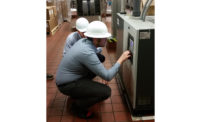Field Reports
Brewery’s pump doesn't need valves
Combined with a flow meter, the positive-displacement pump accurately meters yeast flow.

The first Goose Island Brewery opened its doors on May 13, 1988 in Chicago, IL with the aim of giving US consumers a diverse selection of uniquely crafted beers, much like the ales and lagers found in Europe.
Goose Island’s beer recipes are primarily made from four natural ingredients: malted grain, hops, yeast and water. The brewery is divided into a “hot side” and a “cold side” with distinct sections, each reserved for one part of the brewing process. The work in the brewery is divided into nine steps: malting, milling, mashing, lautering, boiling, fermenting, conditioning, filtering and filling. The brew house (hot side) is responsible for mixing malt, hops and water while the refrigerated cellar (cold side) is where the beer is finished and bottled.

|
|
Goose Island Brewery’s seepex 3-A PC pump meters yeast into fermentation tanks; its flow can be reversed easily for CIP/SIP cleaning. Source: seepex. |
Yeast is largely responsible for the variety of flavor in beer and arguably the most important ingredient in the brewing process. It helps in the metabolic processes that produce ethanol (alcohol) and carbon dioxide (bubbles and foam). Fermentation begins immediately after the yeast begins consuming the sugar source in the wort. After a period in the fermentation vessel, the beer is ready to go into tanks where it is further carbonated, filtered and packaged in bottles or kegs for distribution. Goose Island uses more than 20 different strains of yeast in perfecting its recipes. On any given day, the brewery transfers up to four yeast strains to a fermenter.
During the brewing process, safely delivering “viable yeast” on a daily basis is extremely important since the recipe is compromised if the yeast isn’t handled properly. For yeast transfer from tank to tank, Goose Island’s Fulton Street brewery uses a seepex food-grade BCSO 10-6L progressive cavity (PC) pump, conveniently mounted on a rolling cart for easy mobility.
Brian Taylor, Goose Island’s head cellarman, is responsible for overseeing fermentation and filtration processes. He says, “ A good yeast pump needs to deliver an exact amount of yeast for fermentations to stay on track. We added a flow meter to the pump as well. Our cellarmen can set the gallons specified, walk away and know the pump will shut off once that number is reached. That is not the case with other pumps.”
In a progressive cavity pump, a single helix rotor turns inside a double helix stator to create cavities that progress from the suction to discharge to create flow. The compression fit between the rotor and stator creates seal lines that keep the cavities separate as they move through the pump with each rotation. The result is flow with very little pulsation and low shear rates. This type of pump is particularly well suited to the brewery’s application due to its valveless design. The PC pump is actually a pump and control valve in one and can pull yeast flow in both directions.
Additionally, the PC pump is CIP and SIP capable and meets 3-A standards. “Since the pump is multi-directional, we are able to sanitize our lines with acid going forward,” says Taylor. “Once we have sanitized our hoses and seepex pump, we change directions, open our pitching fermenter and start the pump in reverse. When we reach our calculated pitch volume, the pitching tank is closed. Hot water and chemicals are then sent through the pump in forward position. Obviously, this is a great component for a brewery. We can now sanitize without disconnecting hoses or risking infection.” v
For more information: Aaron Renick, 937-864-7150, sales@seepex.net
Looking for a reprint of this article?
From high-res PDFs to custom plaques, order your copy today!






